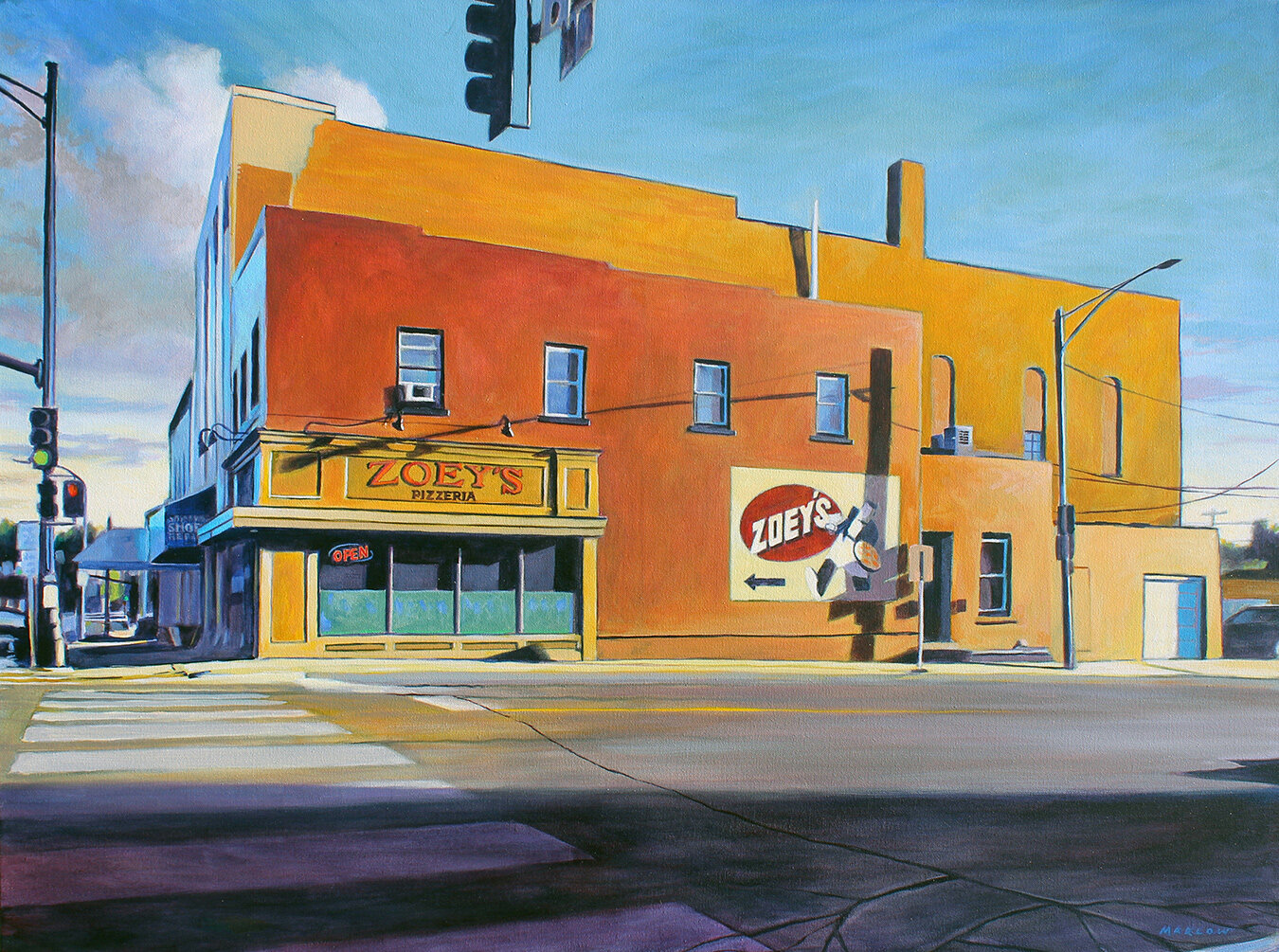See the Light: The real-life inspiration behind the paintings
In 2019, artist Paul Marlow painted a simple group of buildings in Marion, Iowa.
Exactly one year later—to the minute—the artist returned to photograph the subject of this work: Zoey’s Pizzeria, July 5, 7:16 pm. He wanted to see how the light and shadows compared to his painting from the previous year. Along with his brother Patric, he was there also to pick up a large Chicago-style pizza, but that was not his main objective: He was there to see the light.
Painting of Zoey’s Pizzeria, July 5, 7:16 pm, 2019. 30 in. x 40 in. Acrylic on canvas.
Many of Marlow's paintings reflect his interest in American realist painter Edward Hopper's style, which is very much in evidence here, with its realistic depiction of an American scene expressed in the strong contrasts between shadow and light.
In Zoey’s Pizzeria, July 5, 7:16 pm, we see before us an uninhabited small town scene. The background consists of the sky, punctuated by streetlights, telephone poles, and vents – all indicators of contact with people and the outside world. In the middle ground sit the brick buildings, with shops below at street level, the pizzeria with it’s vintage billboard—and the foreground of 7th Avenue in partial shadow. The avenue also connects to the outside world, leading out of town. They contrast with the time-worn, but stately and enduring presence of the warmly lit pizzeria. The streetlights balance all the horizontals in the painting while helping to fill in the negative space of the sky. Significantly, it is the warm, end-of-day light on the rich red surface that has captured the artist's attention.
“Lately, I have been feeling more sentimental regarding memories of my past. Perhaps we all have, especially during the pandemic. We know that we are in a time of change. So we are yearning for the happiness we felt in a former place, time or situation. I want to capture that feeling.”
On the surface, the painting is an homage to one of the artist’s favorite restaurants, but it is much more than that. It is a love of light, and an example of the use of light to create an ethereal mood. It is straightforward and conveys a sense of isolation, yet the lighting softens these characteristics.
“I have always been interested in capturing the feeling of a place.” says Marlow. “There is something very American about this subject—a balance of beautiful light, small town architecture and cultural nostalgia. I have been thinking a lot about nostalgia, and how it affects the way we see things. Nostalgia often sees only the good and ignores the bad. It can be a delicate, bitter-sweet lie we tell ourselves. But nostalgia doesn’t have to be negative—however, I want to portray it honestly. That’s why it was important to show the cracks in the pavement, the imperfections and rough-edges. Showing the truth makes it more real.”
One Year Later—Photograph of Zoey’s Pizzeria, July 5, 7:16 pm, 2020. One addition: A sign in the window announcing the dining room is now open—a result of the pandemic. Two subtractions: Smitty’s Shoe Repair is gone, and the street signs on the light pole to the right have been removed.
“Lately, I have been feeling more sentimental regarding memories of my past. Perhaps we all have, especially during the pandemic. We know that we are in a time of change. So we are yearning for the happiness we felt in a former place, time or situation. I want to capture that feeling.”
Another recent work inspired by real life: Fanfare for the Mailman (W 56th & 9th Ave, NYC) features a New York City postal worker, pushing a cart full of packages across 9th Avenue in Midtown Manhattan. It was March 20, 2019 and Marlow was visiting a chilly New York with his wife and daughter.
Fanfare for the Mailman (W 56th & 9th Ave, NYC), 2020, Oil on Canvas, 30 in. x 40 in.
Far beyond simply capturing the light of Hopper’s New York, Marlow has tried to capture the quintessential essence of the great American city in this one scene. The composition, though busy, is straightforward. The viewer goes immediately to the postal worker, guided by converging perspective lines. The sky and pavement break up the complex buildings and construction site chaos. Marlow also suggests that the worker is moving symbolically from order to chaos—a way of confronting current life in America. There is a sense of transforming the present into some kind of time capsule—a period picture.
“He seemingly forges on with his burden, going from lightness/order, to darkness and chaos. He is an American allegory. I wonder what has become of him.”
Marlow writes, “I knew at that moment I would paint this man and this scene. He was like a hero out of Greek mythology—a twenty-first century Sisyphean man, condemned to push that boulder up a mountain for all eternity. After the pandemic erupted, his story took on added significance.”
Marlow was in the back of a NYC taxi, when he passed this postal delivery man, who became the subject of Fanfare for the Mailman (W 56th & 9th Ave, NYC)
”This work is an elegy, a fanfare for the common man and essential worker. He seemingly forges on with his burden, going from lightness/order, to darkness and chaos. He is an American allegory. I wonder what has become of him.”
In the middle of 5th Avenue: Paul Marlow at the Guggenheim, March 2019.
Marlow works hard to present the appearance of the truth in painting as his first effect. His paintings offer something familiar to draw the viewer in and, at the same time, focus on the unexpected or overlooked. Marlow is a storyteller, and his work shows us that these stories are constructed as deceptively simple truths: the past, like the present, is complicated, untidy, and contradictory. The fact that histories have multiple points of view is a given for Marlow, and his work offers these perspectives for the viewer both to experience and reveal.
The artist Georg Baselitz once said, “This idea of “looking toward the future” is nonsense. I realized that simply going backwards is better. You stand in the rear of the train—looking at the tracks flying back below—or you stand at the stern of a boat and look back—looking back at what’s gone.”
Rather than dwelling in the past, Marlow’s work tends to focus on the here-and-now, but in a way that captures his subject in the process of change. The persistence of change in Marlow’s work explain how our present came to be. Finding beauty in that change, and in the remarkable beauty of unremarkable places, seems to be an ongoing mission for this artist.
“We have art for a very good reason. All of us need a gentle nudge to open our eyes, see beauty in humble places, and value how it feels as experience washes over us.”





